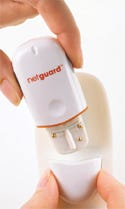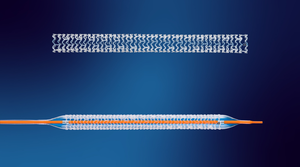Wireless ECG Enables Economic Patient Monitoring
Tweaking a supplier’s valve resulted in enhanced comfort for prosthetics patients
May 1, 2008
Originally Published MPMN May 2008
ENGINEERING EXCELLENCE
Wireless ECG Enables Economic Patient Monitoring
|
The NetGuard wireless ECG monitoring system weighs less than one ounce and costs a fraction of what conventional monitors cost. |
Hospitals are familiar with 20/20 hindsight. When a patient dies on their watch, they investigate why and how it happened. In doing so, they can learn what steps could have been taken to prevent the death. Thousands of unmonitored hospital patients die each year due to dangerous heart rhythms or other unexpected cardiac events. Many of these incidents could have been avoided had monitoring equipment and staff been available. Now, an economical patient-monitoring system can provide hospitals with the 20/20 foresight they’ve long desired.
Continuous monitoring of patients can enable immediate detection and early treatment of abnormal heart rhythms or cardiac events—a concept Datascope Corp. (Montvale, NJ; www.datascope.com) knows something about from manufacturing patient-monitoring and cardiac-assist devices. “We wondered whether the technology was available for us to develop a product which could expand the population of electronically monitored patients and thereby offer a device to clinicians to intervene quickly and improve the patient’s chance of survival,” says Gary Manning, director, NetGuard business, for Datascope. “There is published clinical data that report an estimated 25% of all in-hospital cardiac arrests occur in unmonitored patients. If the clinicians had expected these patients to have cardiac arrest, they would have likely been attached to an electronic monitor,” he adds.
Manufactured by Datascope, the MDEA-winning NetGuard system is a wireless ECG monitor that weighs less than 1 oz and communicates with a standard PC. When a dangerous rhythm is detected, individual monitors can send an alert to a PC at a nurse’s station. The nurse then views the ECG from the monitoring device on the PC and proceeds in accordance with hospital protocol, calling an emergency code, for example. As many as 50 patients equipped with wireless NetGuard units can be continuously monitored on one PC.
The cost of the system, including the reusable portion of the ECG monitor, is a fraction of the cost of conventional monitors, according to Datascope. Affordability was one of the manufacturer’s main goals in the design of the product.
Part of the challenge of manufacturing this product—in addition to making the product cost-effective—was integrating Datascope’s prepackaged unit with the disposable portion of the device provided by Lead-Lok Inc. (Sandpoint, ID; www.leadlok.com). Using a battery roughly the size of a quarter, silver/silver chloride electrodes, and a conductive adhesive, Lead-Lok engineered the circuitry that connected its single-use components to the manufacturer’s waterproof electronic telemetry unit. “It required that we do some hand connections and manufacture the templates and tools to make it all work together,” says Jim Healy, Lead-Lok chairman of the board. “I think it’s going to be a great asset for the medical society and patients to be able to monitor their activity throughout the hospital in such a small, convenient package.”
Meeting Datascope’s size specifications caused a series of design concerns for plastic engineering provider Corex Design Group Inc. (Glen Rock, NJ). “Some of these issues included overmolding circuit boards, critical watertight seals, tight molding tolerances, [and the] ability to manufacture at a low cost,” says principal Mark Rosen.
Further design challenges were encountered by United Plastics Group Inc. (UPG; Anaheim, CA; www.upgintl.com) in terms of maintaining aesthetics. The company assisted Datascope in the design of the plastic components and assembly. “We recommended things like sonic welding, plastic materials, pad-printing, and improvements in assembly,” says Robert Morton, UPG applications engineer. Stratos Product Development LLC (Seattle; www.stratos.com) contributed its wireless systems design expertise to Datascope’s unit as well. “Each of the vendors assisted in their own areas of expertise to make the product manufacturable,” adds Morton.
Copyright ©2008 Medical Product Manufacturing News
You May Also Like



